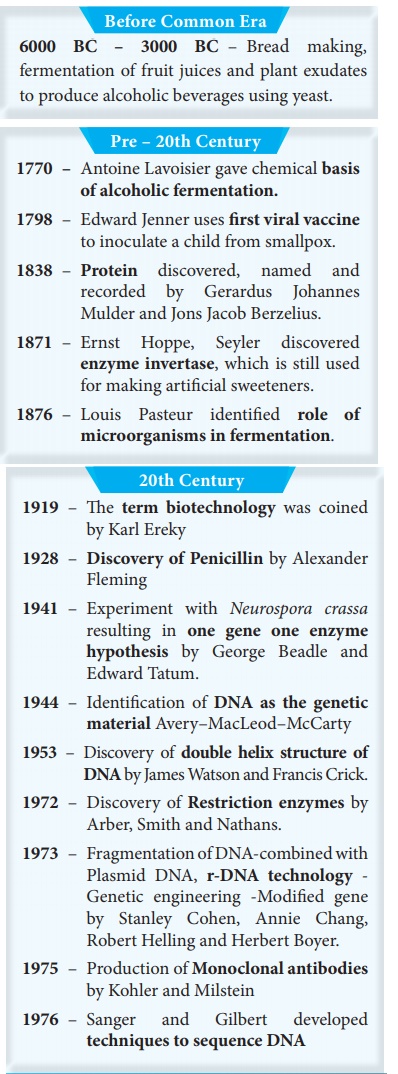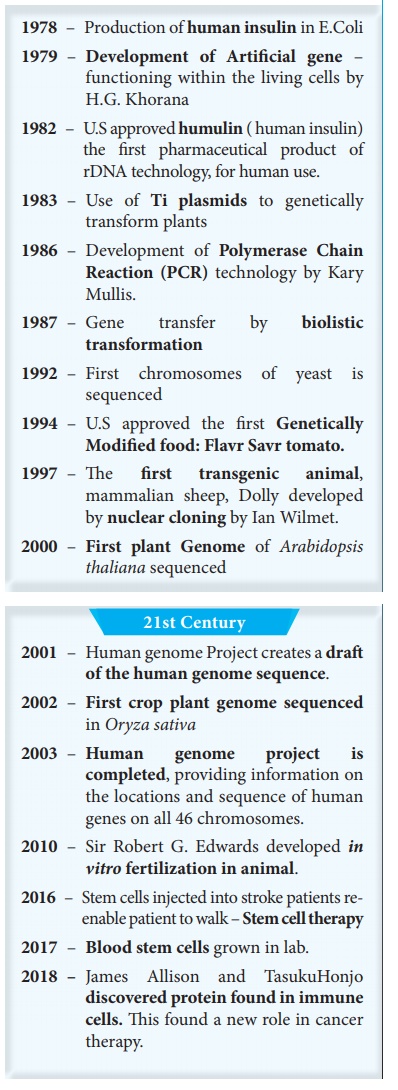Botany - Historical Perspective of Biotechnology | 12th Botany : Chapter 4 : Principles and Processes of Biotechnology
Chapter: 12th Botany : Chapter 4 : Principles and Processes of Biotechnology
Historical Perspective of Biotechnology
Historical Perspective


Before Common Era
6000
BC – 3000 BC – Bread making, fermentation of fruit juices and plant exudates to
produce alcoholic beverages using yeast.
Pre – 20th Century
1770
– Antoine Lavoisier gave chemical basis of alcoholic fermentation.
1798
– Edward Jenner uses first viral vaccine to inoculate a child from smallpox.
1838
– Protein discovered, named and recorded by Gerardus Johannes Mulder and Jons
Jacob Berzelius.
1871
– Ernst Hoppe, Seyler discovered enzyme invertase, which is still used for
making artificial sweeteners.
1876
– Louis Pasteur identified role of microorganisms in fermentation.
20th Century
1919
– The term biotechnology was coined by Karl Ereky
1928
– Discovery of Penicillin by Alexander Fleming
1941
– Experiment with Neurospora crassa resulting in one gene one enzyme hypothesis
by George Beadle and Edward Tatum.
1944
– Identification of DNA as the genetic material Avery–MacLeod–McCarty
1953
– Discovery of double helix structure of DNA by James Watson and Francis Crick.
1972
– Discovery of Restriction enzymes by Arber, Smith and Nathans.
1973
– Fragmentation of DNA-combined with Plasmid DNA, r-DNA technology - Genetic
engineering -Modified gene by Stanley Cohen, Annie Chang, Robert Helling and
Herbert Boyer.
1975
– Production of Monoclonal antibodies by Kohler and Milstein
1976
– Sanger and Gilbert developed techniques to sequence DNA
1978
– Production of human insulin in E.Coli
1979
– Development of Artificial gene – functioning within the living cells by H.G.
Khorana
1982
– U.S approved humulin ( human insulin) the first pharmaceutical product of
rDNA technology, for human use.
1983
– Use of Ti plasmids to genetically transform plants
1986
– Development of Polymerase Chain Reaction (PCR) technology by Kary Mullis.
1987
– Gene transfer by biolistic transformation
1992
– First chromosomes of yeast is sequenced
1994
– U.S approved the first Genetically Modified food: Flavr Savr tomato.
1997
– The first transgenic animal, mammalian sheep, Dolly developed by nuclear
cloning by Ian Wilmet.
2000
– First plant Genome of Arabidopsis thaliana sequenced
21st Century
2001
– Human genome Project creates a draft of the human genome sequence.
2002
– First crop plant genome sequenced in Oryza sativa
2003
– Human genome project is completed, providing information on the locations and
sequence of human genes on all 46 chromosomes.
2010
– Sir Robert G. Edwards developed in vitro fertilization in animal.
2016
– Stem cells injected into stroke patients re-enable patient to walk – Stem
cell therapy
2017
– Blood stem cells grown in lab.
2018
– James Allison and TasukuHonjo discovered protein found in immune cells. This
found a new role in cancer therapy.
Related Topics